You can appreciate the advantages of a well-equipped parking in the country on the very first rainy day. The construction of the parking lot is often carried out on their own using various materials. It is desirable that the structure is not expensive, and also combines functionality and an attractive appearance. It is necessary to familiarize yourself with the intricacies of construction before starting construction.
Site arrangement options
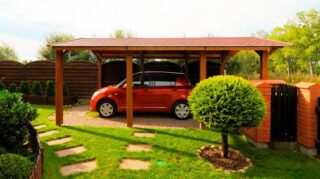
The parking lot in the country is designed to perform several tasks:
- Facilitate smooth entry / exit in rainy weather when the ground turns to mud;
- provide an opportunity to wash the car;
- serve as a place for changing wheels or minor repairs;
- be a shelter from the sun and strangers;
- reduce the likelihood of getting your shoes dirty when getting in / out of the car;
- be an element of decorative design.
Not every coating provides the performance of all functions at the same time, therefore, when designing and choosing an option, they take into account their needs. For example, a concrete pavement does not absorb water, and on a natural lawn, the jack will pound the soil.
Most often, the coverage of a parking space in the country is:
- grass;
- sand, crushed stone or gravel;
- natural stone;
- poured concrete or concrete slabs;
- paving slabs;
- lawn geogrid.
Each option has pros and cons, as well as a different price and required construction labor.
Seat selection
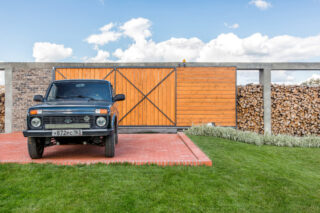
Inland, there are no special restrictions on design, location and functionality.
It is forbidden to wash cars in the parking lots outside the site. The option of covering for the parking lot outside the cottage must be coordinated with the board of the society or with the administration of the settlement - if communications pass at the place of the planned parking, then during excavation work, the destroyed covering will have to be restored at its own expense.
To make parking at the summer cottage convenient, the following conditions are taken into account when choosing a place:
- In the immediate vicinity of the house, a trampled or concreted area spoils the appearance from the window; flowers or trees cannot be planted in this place.
- The location of the parking lot is chosen directly behind the entrance, saving internal space and money for arranging the path from the parking lot to the house.
- For summer cottages, it is advisable to locate the parking in a place protected from the sun, for example, behind the north wall of the house.
- For winter use, they are guided by the experience of previous years - as a rule, snow drifts occur at certain places on the site and it is undesirable to park there, each exit will begin with digging up the car.
- They do not have a parking lot under tall trees, especially fruit trees - bird droppings are chemically aggressive and quickly corrode even car enamel. You will have to remove traces of bird activity before each trip.
- The size of the parking lot at the dacha can be chosen at your discretion, focusing on the dimensions of the car. A minimum margin of 70 cm should be left on each side, so that when boarding / disembarking, it fits on a hard surface and does not stain clothes on doors that are dirty in slush. For two cars, the parking lot is increased in length or width.
Considering all the factors, a compromise option is chosen - the distance from home to the parking lot should be minimal in order to facilitate the movement of goods, but at the same time, other conditions were met. The choice of coverage is important.
Green lawn parking

Growing grass to cover the parking lot is not easy - a solid carpet that can withstand a car will cover the ground in at least 2 seasons. Until that time, each entrance to the green zone will spoil the appearance.
Benefits of grass cover:
- cheapness;
- ease of arrangement;
- water permeability.
There are more disadvantages to lawn parking than advantages:
- in the off-season, the soil will sink, a track will form;
- shoes get wet in wet weather;
- it is possible to raise the car with a jack only in dry weather;
- the lawn requires constant care: watering and mowing;
- attractiveness is lost in winter.
To set up a secure base for a grass-covered parking lot:
- They dig a pit 30 cm deep.
- The bottom is covered with a layer of rubble or gravel mixed with sand. The height of the pillow is 15–20 cm. The layer is spilled with water and tamped.
- Fertile soil is poured 5-10 cm above the ground level - with shrinkage, leveling will occur.
- Sow the grass, it is better to choose a mixture for sports fields.
- Grow a lawn.
Use the green parking lot after the ground is turfed and the grass is strong enough to withstand vehicle passes.
Crushed stone or gravel site
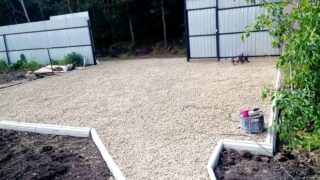
A practical, inexpensive and quick way to arrange parking for a car in the country is to fill the surface with a fine fraction of crushed stone or gravel.
Coating advantages:
- versatility - withstands the weight of any vehicle, suitable for technical maintenance;
- water permeability - water does not accumulate on the surface from precipitation and when washing the car;
- attractive appearance, there are crushed stone of different colors on sale;
- it is easy to restore the surface if a track has formed with frequent use;
- the ability to combine with geogrids.
There are practically no drawbacks, with the exception of a few that do not really affect functionality:
- difficulty clearing snow;
- inconvenience of walking in high or thin heels;
- germination of shoots from nearby trees, such as plums or cherries, is possible.
In addition, for the correct arrangement, material of different fractions will be required, and for small parking lots the cost may increase due to the fact that it is necessary to pay for 2 deliveries.
Material selection
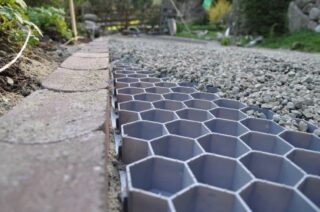
As a base and coating, a popular natural material is:
- river gravel with smooth, even edges is environmentally friendly, has an attractive appearance;
- crushed granite is a solid rock, but it should be borne in mind that it is often with an increased background radiation.
Crushed limestone for parking in a private house in the open air is not used due to its rapid destruction and the formation of white streaks.
An alternative to crushed stone is dumping with waste from metallurgical industries. It differs in different amounts in the composition of iron. A fraction with a small proportion of metal is destroyed within 2–3 years to the state of crumbs and dust, and partly goes into the ground. You will need to do a bedding, so the material is purchased with a margin of 10-15%.
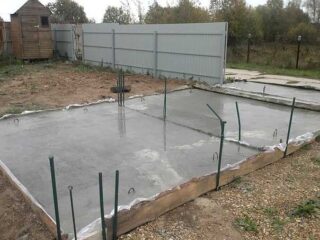
Construction algorithm:
- Calculate the amount of material required. Sand will be required for a layer of 15 cm and mixing concrete for installing curbs. A coarse fraction of crushed stone should be enough for filling 15 cm, and a small stone for a surface layer 5 cm thick. Cement 1 bag (50 kg) for parking for one parking space.
- Excavation of soil 30–35 cm is carried out, the roots of perennial herbaceous plants and garden trees are removed, and the site is planned.
- Pour 15 cm of sand, 2–3 spill abundantly with water for shrinkage, ram.
- A curb is built around the entire perimeter of the parking lot. At one end and on the sides, the fence should be 5–15 cm higher than the ground level, and on the side of the entrance it should have a slope to exclude a step. They use curb stones, build timber formwork.
- If desired, lay geotextiles, it will reduce the likelihood of vegetation germination, but you can do without it.
- Fall asleep and tamp 15 cm of the coarse fraction of crushed stone.
- Lay the top cover of a small stone, about 5 cm thick. The thinner layer will gradually expose the coarse fraction, and if you make it thicker, you will periodically have to remove the track.
A budget option is to fill the parking lot for a car at the dacha with used asphalt crumbs, which can be purchased quite inexpensively. The option is inferior to crushed stone only in the design of the site, without losing in functionality.
Concrete slabs or concrete casting
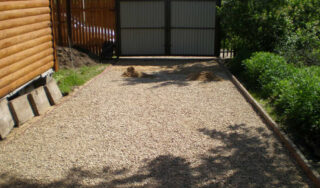
Concrete paving slabs are a common parking arrangement.
Benefits:
- the greatest durability compared to other options;
- perfectly flat surface;
- strength sufficient to withstand a personal car of any mass;
- the possibility of building up a parking space by simply adding slabs.
The disadvantages are related to the costs of the arrangement:
- factory quality slabs are expensive;
- you need to pay for delivery services;
- high rental price of a truck crane for a short period of time;
- possible movements on heaving soils.
Construction procedure:
- They dig a pit 15–20 cm deep.
- Pour a sand pillow flush with the ground. Spill with water for shrinkage, adding sand if necessary. Carefully level the base.
- Plates are being laid.
- Seams are poured with concrete or cement-sand mortar.
Do-it-yourself parking, poured out of concrete, is an alternative to slabs.
When pouring concrete on heaving soils without a reliable foundation, the parking lot may be destroyed in winter. It is necessary to make a high cushion and ensure water drainage at least 50 cm from the parking lot.
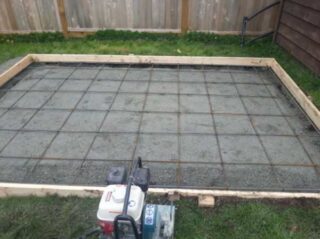
Construction is carried out in several stages:
- The soil is chosen to a depth of 20 cm.
- They arrange the formwork so that the upper edge rises 10 cm above the total surface of the site, an exit is provided in the direction of the entrance to the site. A slope of 2 cm per meter of length is arranged from the middle to the edges, which will ensure water drainage.
- A layer of sand 10-15 cm is poured, spilled with water, tamped.
- A lattice of reinforcement with a diameter of 10 mm or more is mounted. For parking for one passenger car, you can do without reinforcement.
- Concrete is poured with a layer of 10 cm. The proportions of cement, sand, filler 1: 2.5: 3.5. In hot weather, spill water every two hours to prevent cracks from forming.
- After 2-3 days, a screed with a thickness of 5 cm or more is poured; a masonry mesh made of 3-4 mm wire must be used.
- For several days, if the weather is hot, water the parking lot with water - this will prevent cracking and allow the solution to gain strength.
The concrete is set to full strength for 28 days. If the car is not heavy, you can use the parking lot after 15–20 days.
Paving slabs
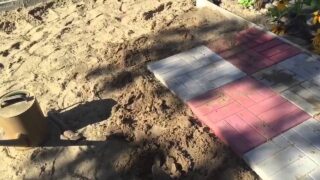
Tile is a great option for heaving plots of land. When moving, the surface can be shifted.
Material advantages:
- durability;
- attractiveness, various colors and shapes;
- functionality and versatility.
Main disadvantages:
- high price of quality products;
- labor intensity of laying;
- compulsory work experience with self-assembly.
Arrangement:
- A pit is being dug with a depth of 20-30 cm.
- Crushed stone is poured, with a fraction of 40-60 cm, the layer thickness is at least 10-15 cm.
- Covering geotextiles.
- Make a pillow from a mixture of sand and cement in a 5: 1 ratio.
- Lay the tiles, observing the slope for water drainage.
- Fill the seams with the same mixture of sand and cement.
Thorough tamping of the cushion is necessary before laying, otherwise the tiles are likely to shift under load.
Using the same technology, you can make a parking lot of natural stone by replacing the tiles.
Lawn grill
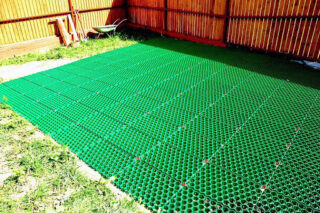
Lawn grids allow you to make parking for any type of transport.
Products are made of plastic and concrete. By resistance to load, light and heavy versions are distinguished.
Benefits of lawn grates:
- long (at least 20 years) service life;
- versatility - the surface allows water to pass through, but remains durable in any weather;
- attractive appearance;
- environmental friendliness;
- relatively simple installation;
- the ability to make platforms of any size by connecting modules.
Among the disadvantages are the fact that the grass does not completely cover the surface, as well as the need to park the car with an offset every time. Otherwise, traces of crushed and withered grass remain.
In hot regions, regular watering of the grass will be required.
Arrangement sequence:
- A pit is being dug with a depth of 20-30 cm.
- Fill in a pillow made of a mixture of sand and gravel, ram it.
- Laying geotextiles.
- Sand is poured with a layer of 10 cm, give time for shrinkage or spill with water, ram.
- Install the grill according to the manufacturer's instructions.
- The honeycomb is filled with fertile soil, the grass is sown.
You can use the platform from the lawn grate right away, but you need to park the car with an offset so that the grass will germinate.








